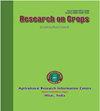受控环境条件下杂交种和植物生长调节剂对彩色辣椒(Capsicum annuum L.)生长、产量和质量的影响
Q3 Agricultural and Biological Sciences
引用次数: 0
摘要
在印度等发展中国家,城市化进程迅速发展,人们的饮食习惯也日新月异。在这种转变下,一部分人开始注重营养安全,蔬菜在日常饮食中扮演着重要角色。在各种蔬菜中,俗称辣椒的彩椒因其营养品质和市场需求而具有重要地位。通过选择性能最佳的杂交种和外源施用植物生长调节剂,可以提高彩色辣椒的质量和产量。有鉴于此,本研究于 2020-21 年和 2021-22 年的 11 月至 4 月在奥迪沙邦 Paralakhemundi 的 Centurion 技术与管理大学保护性栽培单位进行,实验环境受控。实验采用因子随机区组设计,包括两个杂交种,即 Orobelle(黄色)和 Bomby(红色),以及八个生长调节剂处理,分别为 GA3 @ 25 ppm、GA3 @ 50 ppm、GA3 @ 75 ppm、GA3 @ 100 ppm、NAA @ 20 ppm、NAA @ 40 ppm、NAA @ 60 ppm 和 NAA @ 80 ppm。实验中共有 16 个处理组合,重复三次。试验结果表明,在 60 DAS 和 90 DAS 时,所培育的杂交种在产量属性、产量、品质参数和生长属性(不包括株高和单株叶片数)方面没有显著差异。然而,植物生长调节剂对生长特性、产量特性、产量和质量参数有显著影响。施用 NAA @ 80 ppm 会导致提早开花(播种后 43.8 天)。此外,施用 GA3 @ 100 ppm 时,单株花朵数(32.5 朵/株)、花果比(52.9)、单株果实数(19.5)和果实重量(133.6 克)最高。在果实产量方面,各处理组合之间存在明显的交互效应,其中 Bomby 杂交品种在施用 GA3 @ 100ppm 时产量最高。从研究中可以得出结论,可以根据果实颜色和市场需求,考虑在受控环境条件下种植这两种杂交种,同时施用 GA3 @ 100 ppm。本文章由计算机程序翻译,如有差异,请以英文原文为准。
Growth, productivity and quality of colored capsicum (Capsicum annuum L.) as influenced by hybrids and plant growth regulators under controlled environment conditions
In developing countries like India, rapid urbanisation was under way and the diet habits of the people have been changing day to day. Under this transformation, a section of the population is focused on nutritional security where vegetables play a major role in daily diet. Among different vegetables coloured bell pepper which is commonly known as capsicum, has importance due to its nutritional quality and market demand. The quality and productivity of coloured capsicum can be improved by choosing the best performing hybrids and exogenous application of plant growth regulators. Considering the above, the present study was conducted from November to April of 2020-21 and 2021-22 at the Protected Cultivation Unit of Centurion University of Technology and Management, Paralakhemundi, Odisha under controlled environment conditions. The experiment was laid out in factorial randomized block design consisting of two hybrids, namely, Orobelle (yellow colored) and Bomby (red colored); and eight treatments of growth regulators which were GA3 @ 25 ppm, GA3 @ 50 ppm, GA3 @ 75 ppm, GA3 @ 100 ppm, NAA @ 20 ppm, NAA @ 40 ppm, NAA @ 60 ppm and NAA @ 80 ppm. A total of 16 treatment combinations were worked out in the experiment which were replicated thrice. The results of the experiment revealed that there was no significant variation among the hybrids cultivated with respect to yield attributes, yield, quality parameters and growth attributes excluding plant height and number of leaves per plant at 60 DAS and 90 DAS. However, there was a significant impact of plant growth regulators on growth attributes, yield attributes, yield and quality parameters. The application of NAA @ 80 ppm resulted in early flowering (43.8 days after planting). Moreover, the maximum number of flowers per plant (32.5 flowers/plant), flower to fruit ratio (52.9), fruits per plant (19.5) and weight of the fruit (133.6 g) recorded in GA3 @ 100 ppm application. There was a significant interaction effect among treatment combinations in fruit yield where the highest value was recorded in Bomby hybrid with GA3 @ 100 PPM application. From the study it may be concluded that cultivation of both the hybrids can be considered as per the fruit colour and market demand along with the application of GA3 @ 100 ppm under controlled environment conditions.
求助全文
通过发布文献求助,成功后即可免费获取论文全文。
去求助
来源期刊

Research on Crops
Agricultural and Biological Sciences-Soil Science
CiteScore
1.50
自引率
0.00%
发文量
93
审稿时长
1 months
期刊介绍:
The Research on Crops is a peer-reviewed journal publishing original research papers, review articles and short communications in English on all basic and applied aspects of crop sciences, agricultural water management, agro-climatology, agroforestry, agronomy, crop production, crop protection, cropping systems, food science & technology, genetics & plant breeding, horticulture, plant & soil science, plant biotechnology, plant nutrition, post-harvest management of crops, seed science, soil management & tillage, vegetables, weed science, agricultural engineering, agri-business, agricultural economics and extension, etc. The aim of the journal is to provide a forum for the scientific community to publish their latest research findings.
The manuscripts submitted for publication should not contain data older than 4 years on the date of submission.
The articles submitted for publication in this journal should not be submitted elsewhere simultaneously for publication in another journal. These should not carry any copyright material without prior permission of copyright holder.
The articles should present a complete picture of the investigation made and should not be split into parts.
There is no prescribed limit regarding the number of pages in case of full-length articles. However, the authors are advised to keep the length of their articles from 4 to 10 full printed pages of the journal.
The articles should be divided into the sub-sections: ABSTRACT, INTRODUCTION, MATERIALS AND METHODS, RESULTS AND DISCUSSION, CONCLUSIONS, and REFERENCES. Tables and figures should be appended separately at the end.
 求助内容:
求助内容: 应助结果提醒方式:
应助结果提醒方式:


